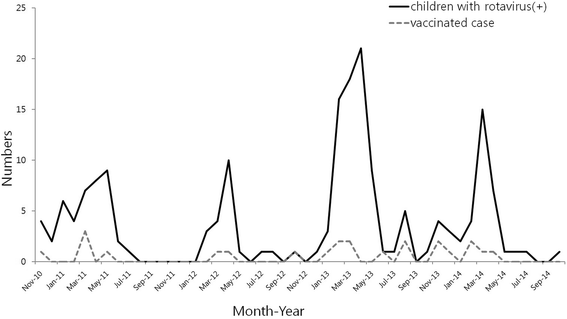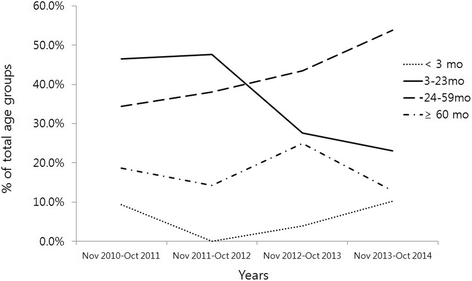Changing distribution of age, clinical severity, and genotypes of rotavirus gastroenteritis in hospitalized children after the introduction of vaccination: a single center study in Seoul between 2011 and 2014
- PMID: 27296987
- PMCID: PMC4906974
- DOI: 10.1186/s12879-016-1623-y
Changing distribution of age, clinical severity, and genotypes of rotavirus gastroenteritis in hospitalized children after the introduction of vaccination: a single center study in Seoul between 2011 and 2014
Abstract
Background: This study aimed to explore changes in clinical epidemiology and genotype distribution and their association among hospitalized children with rotavirus gastroenteritis after the introduction of vaccines.
Methods: Between November 2010 and October 2014, hospitalized children with acute gastroenteritis were enrolled. Rotavirus genotypes were confirmed through reverse transcription-polymerase chain reaction (RT-PCR), semi-nested PCR, and sequencing. Clinical information including vaccination status and the modified Vesikari scores were collected.
Results: Among 179 children with rotavirus infection, nineteen (10.6 %) were completely vaccinated. During the study period, the number of children between three and 23 months of age decreased significantly compared to the number of children older than 24 months of age (P = 0.010), who showed lower diarrhea severity (duration, P = 0.042; frequency, P = 0.021) but higher vomiting severity (P = 0.007, 0.036) compared to the former. Vaccination status was also significantly associated with lower vomiting severity after adjustment for age (frequency only, P = 0.018). The predominant genotypes were G2P[4] (18.4 %), G1P[8] (14.5 %), and G1P[4]P[8] (12.8 %), and the prevalence of genotypes with uncommon and mixed combinations was more than 50 %. Children infected with G2P[4] strains tended to be older (P = 0.005) and had more severe vomiting (P = 0.018, 0.006) than those with G1P[8].
Conclusions: Increase in age of infected, hospitalized children was accompanied by change in clinical severity during 2011-2014 after the introduction of vaccines in Seoul. Clinical severity was also associated with vaccination status and genotype. Long-term large scale studies are needed to document the significance of the increase in genotypes of uncommon and mixed combinations.
Keywords: Age; Clinical severity; Genotype; Rotavirus; Vaccine.
Figures
Similar articles
-
The epidemiology of all-cause and rotavirus acute gastroenteritis and the characteristics of rotavirus circulating strains before and after rotavirus vaccine introduction in Yemen: analysis of hospital-based surveillance data.BMC Infect Dis. 2015 Oct 13;15:418. doi: 10.1186/s12879-015-1165-8. BMC Infect Dis. 2015. PMID: 26464210 Free PMC article.
-
Rotavirus genotype and Vesikari score of outpatients in Japan in the vaccine era.Pediatr Int. 2020 May;62(5):569-575. doi: 10.1111/ped.14150. Epub 2020 Apr 17. Pediatr Int. 2020. PMID: 31957129
-
Diversity of rotavirus genotypes circulating in children < 5 years of age hospitalized for acute gastroenteritis in India from 2005 to 2016: analysis of temporal and regional genotype variation.BMC Infect Dis. 2020 Oct 9;20(1):740. doi: 10.1186/s12879-020-05448-y. BMC Infect Dis. 2020. PMID: 33036575 Free PMC article.
-
Prevalence, Pattern and Genetic Diversity of Rotaviruses among Children under 5 Years of Age with Acute Gastroenteritis in South Africa: A Systematic Review and Meta-Analysis.Viruses. 2021 Sep 23;13(10):1905. doi: 10.3390/v13101905. Viruses. 2021. PMID: 34696335 Free PMC article.
-
Rotavirus Genotypes Circulating in Brazil Before and After the National Rotavirus Vaccine Program: A Review.Pediatr Infect Dis J. 2018 Mar;37(3):e63-e65. doi: 10.1097/INF.0000000000001770. Pediatr Infect Dis J. 2018. PMID: 29189673 Review.
Cited by
-
Differences in epidemiology of enteropathogens in children pre- and post-rotavirus vaccine introduction in Kilifi, coastal Kenya.Gut Pathog. 2022 Aug 1;14(1):32. doi: 10.1186/s13099-022-00506-z. Gut Pathog. 2022. PMID: 35915480 Free PMC article.
-
Molecular Epidemiology of Rotavirus Strains in Symptomatic and Asymptomatic Children in Manhiça District, Southern Mozambique 2008-2019.Viruses. 2022 Jan 12;14(1):134. doi: 10.3390/v14010134. Viruses. 2022. PMID: 35062336 Free PMC article.
-
Benign Convulsions with Mild Rotavirus and Norovirus Gastroenteritis: Nationwide Data from the Health Insurance Review and Assessment Service in South Korea.Children (Basel). 2021 Mar 30;8(4):263. doi: 10.3390/children8040263. Children (Basel). 2021. PMID: 33808239 Free PMC article.
-
Epidemiology of Rotavirus Gastroenteritis and Rotavirus-Associated Benign Convulsions with Mild Gastroenteritis after the Introduction of Rotavirus Vaccines in South Korea: Nationwide Data from the Health Insurance Review and Assessment Service.Int J Environ Res Public Health. 2020 Nov 12;17(22):8374. doi: 10.3390/ijerph17228374. Int J Environ Res Public Health. 2020. PMID: 33198275 Free PMC article.
-
Group A Rotavirus Detection and Genotype Distribution before and after Introduction of a National Immunisation Programme in Ireland: 2015-2019.Pathogens. 2020 Jun 7;9(6):449. doi: 10.3390/pathogens9060449. Pathogens. 2020. PMID: 32517307 Free PMC article.
References
-
- World Health Organization Rotavirus vaccines. WHO position paper - January 2013. Wkly Epidemiol Rec. 2013;88:49–64. - PubMed
-
- Matthijnssens J, Joelsson DB, Warakomski DJ, Zhou T, Mathis PK, van Maanen MH, et al. Molecular and biological characterization of the 5 human-bovine rotavirus (WC3)-based reassortant strains of the pentavalent rotavirus vaccine, RotaTeq. Virology. 2010;403:111–27. doi: 10.1016/j.virol.2010.04.004. - DOI - PubMed
-
- Sohn T, Lee C, Kim Y, Kang M, Kim S, Lee S, et al. Clinical and epidemiological study of 1,165 Hospitalized cases of rotaviral gastroenteritis before and after the introduction of rotavirus vaccine, 2006–2013. Korean J Pediatr Infect Dis. 2014;21:174–80.
MeSH terms
Substances
LinkOut - more resources
Full Text Sources
Other Literature Sources
Medical



